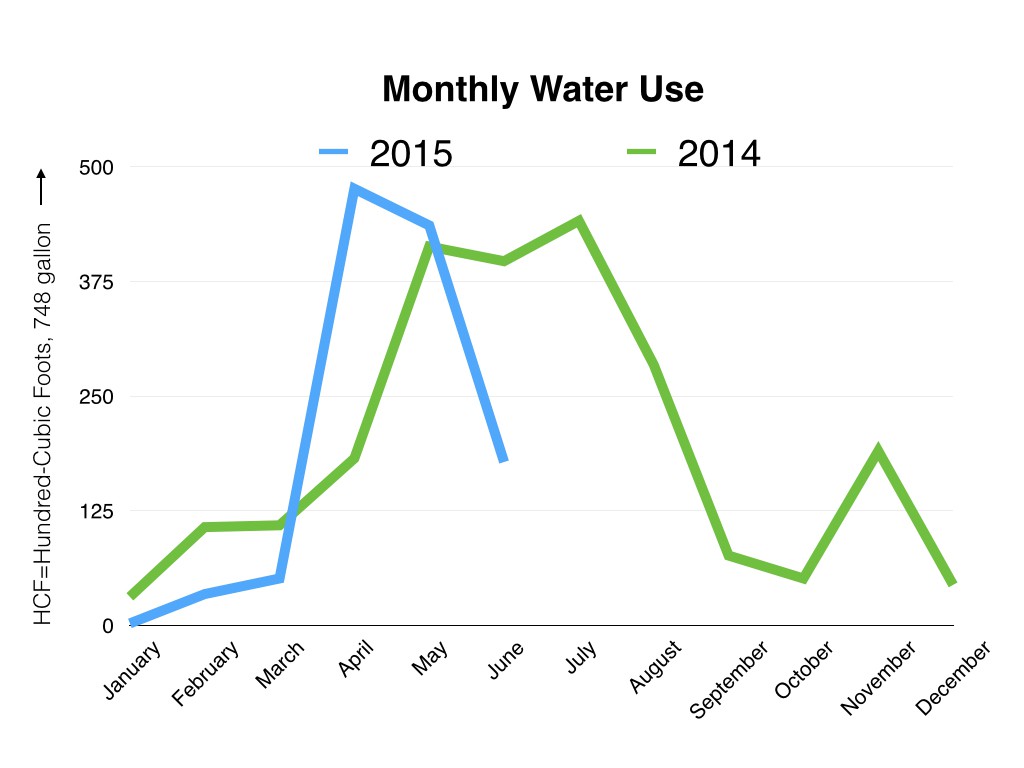Last year, under professional vineyard management, the annual water consumption of the vineyard was 2325 HCF.
HCF stands for Hundred Cubic Foot, equal to 748 gallons.
This years goal is to save 25%, that makes the target consumption 1750 HCF.

After starting timer-based irrigation in Spring, it took some trial and error to get the system properly set up. Now it is dialed in, and the effect is clear from the June month reduction. From this data, 25% less water use looks a feasible goal.
However, Summer just started and we are looking forward to having quite some dry days with temperatures well over 100F.
The challenge will be to meet the target without impacting the crop yield.
The 2014 curve (green, below graph) follows a typical shape, reduced irrigation is starting well before harvest.

The vineyard location does not have Internet. It's a rural area and choices are limited.
I tried a DSL connection, but latency was so bad that it was practically unusable.
My project for this weekend is to try and set up an Android phone as WiFi hotspot.
Took me two drives to the phone store to get a suitable data-only plan.
I have it "kind of" working now. However, the hotspot tethering feature stops after 30 minutes or so.
Suggestions welcome :-)
 Reinier van der Lee
Reinier van der Lee
Discussions
Become a Hackaday.io Member
Create an account to leave a comment. Already have an account? Log In.
Christoph, thanks for the feedback, plots updated.
Research on the subject states that once a day measurement provides sufficient data for irrigation management. That's why you can make this system work by walking around once a day with a handheld reader. Low tech, but effective nonetheless.
To understand the dynamics of soil moisture penetration, and help fine tune irrigation frequency and quantity, a higher measurement rate really helps. Many farmers live at a considerable distance from their crops. Im my case, I need to drive over an hour to get to the vineyard. Live data feed (wifi hotspot) is very welcome.
I was reading about Broadband-Hamnet last night. This is a ham radio mesh network of "hacked" routers (using high gain antennas). I ran into it because "Broadband-Hamnet" shows up on my list of available wifi hotspots. If there is sufficient coverage to make it between Temecula and my home (65 miles) this may be an option I want to look into later.
Are you sure? yes | no
thanks for the labels, the plots are much clearer now and actually encourage making comparisons.
As you are in a country with good infrastructure I'm sure you'll be able to establish a reliable connection to your wineyard. I'm looking forward to the results for the next couple of months, and how the actual product turns out. But that's probably taking much more time to find out.
Are you sure? yes | no
also please add labels to your plots' y axes - I really don't know what the second plot is showing
Are you sure? yes | no
Do you need real time data or would it be sufficient to collect data with a mobile hotspot from time to time?
Are you sure? yes | no
Research suggests that once a day measurement is sufficient for irrigation management. I just got my system live on the Internet, providing live data. As changes happen slowly, having a graphical presentation, like ThingSpeak, is helpful seeing trends.
Are you sure? yes | no